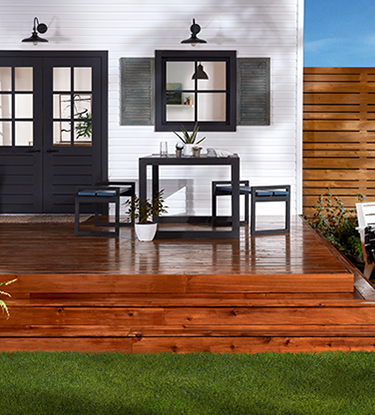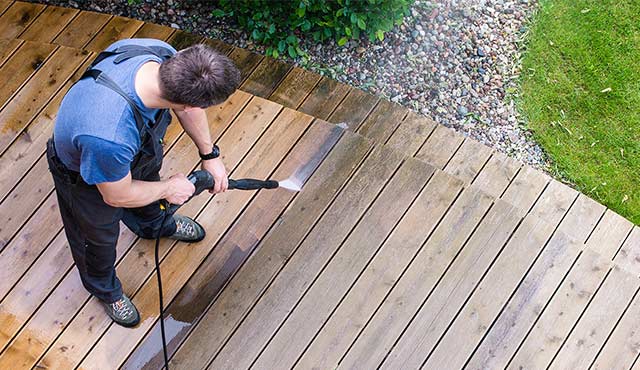Water-Based Stains for a Beautiful Deck: Eco-Friendly and Effective
Water-Based Stains for a Beautiful Deck: Eco-Friendly and Effective
Blog Article
A Comprehensive Guide to Different Sorts Of Deck Staining Techniques for Ultimate Security and Aesthetics
In the realm of deck maintenance, the art of discoloring stands as an essential step in the direction of both preserving the honesty of your outside area and improving its visual charm. As we navigate with the elaborate world of deck staining methods, one begins to value the nuanced strategies that can make all the distinction in between a mediocre surface and a flawless one. From the selection of the ideal tarnish type to the precise application methods, each element plays a vital duty in attaining that excellent equilibrium in between defense and aesthetics. Join us as we discover the secrets behind achieving the best deck staining results-- a trip where every brushstroke shapes not just the surface area, but the really essence of your outside sanctuary.
Understanding Various Kinds Of Discolorations
Numerous kinds of stains are typically used in the process of deck staining to achieve various visual and safety results. On the various other hand, semi-transparent discolorations offer an equilibrium in between shade improvement and security, enabling some wood grain to reveal through.
Moreover, there are also specialized stains such as toners and sealants. Toners include a tip of shade to the timber while offering minimal protection, making them appropriate for newer decks with less wear. Sealers, on the various other hand, offer protection versus dampness and UV rays without including shade, making them a popular selection for decks that already boast a preferable tone. Comprehending the qualities and benefits of each sort of stain is essential for attaining the desired look and longevity for your deck.
Selecting the Right Stain Color
When considering the aesthetic appeals of your deck discoloration project, the option of discolor color plays an important role in boosting the safety high qualities of the selected discolor type (Beautiful Deck). The color you select can substantially influence the overall look of your deck, in addition to its capability to stand up to the elements with time
When choosing a discolor color, it's vital to think about the existing color plan of your home's outside. Integrating the deck tarnish with the overall aesthetic of your residential property can create a natural and visually appealing outdoor space. Additionally, the color of your deck stain can influence the temperature level of the deck surface area; darker shades often tend to absorb even more heat, while lighter colors show sunshine and remain cooler.
Moreover, the kind of timber you are discoloring will also impact just how the tarnish shade appears. Various timber varieties can communicate with the stain in different methods, potentially modifying the final color. It's a good idea to evaluate the discolor on a little, unnoticeable location of the deck to guarantee the shade turns out as preferred before continuing with the entire task.
Preparing Your Deck for Discoloration
To make certain a lasting and effective deck staining task, extensive prep work of the deck surface is crucial. Begin by cleaning the deck completely to get rid of dirt, crud, mildew, and any old finish or tarnish. Use a deck cleaner or a blend of water and detergent in addition to a tight brush or stress washing machine to scrub the surface area clean. After cleansing, permit the deck to completely dry completely prior to carrying on to the following action.
Evaluate the deck for any damaged or rotten boards that need to be replaced. Hammer down any type of protruding nails and sand any rough locations to guarantee a smooth surface area for staining. Look for any type of loose railings or actions that may need tightening or fixing.
When the deck is clean, dry, and in excellent repair work, take into consideration using a timber brightener to restore the deck's all-natural shade and open up the timber pores for better tarnish penetration. Finally, shield any neighboring plants, furniture, or surface areas a knockout post with plastic sheet before proceeding with the staining process. Proper preparation is key to achieving a professional-looking coating and optimizing the longevity of your deck tarnish.
Applying Spot With Various Strategies
For webpage a expert and perfect finish, the technique of applying stain plays a crucial role in enhancing the appearance and longevity of your deck. There are a number of strategies you can utilize to make sure an efficient application of tarnish.
Cleaning is a typical technique that enables for precision and control over the quantity of tarnish applied. It is perfect for intricate locations and getting to between deck boards (Right Deck Stain). Rolling is a quicker alternative, covering larger area successfully. Back-brushing after rolling is recommended to also out the discolor and work it right into the timber for much better penetration.
Splashing is one more preferred technique, offering rate and ease of application, especially for big deck areas. It is vital to make use of a top notch sprayer and bear in mind overspray. Pad applicators provide a smooth and even finish and appropriate for both straight and upright surface areas. Whichever strategy you select, ensuring correct preparation and complying with supplier standards will certainly assist attain a long-lasting and gorgeous stain surface on your deck.

Maintaining and Re-staining Your Deck
When it comes to re-staining your deck, the frequency depends on numerous factors such as the kind of discolor made use of, the environment in your area, and how much wear and tear your deck experiences. Generally, it is advised to re-stain your deck every 2-4 years to keep its defense and appearances.
Before re-staining, guarantee the deck is tidy, dry, and free of any kind of previous discolor residue. Pick a high-grade recommended you read stain that suits your deck's material and supplies the preferred degree of security.
Conclusion
Finally, recognizing the different sorts of deck discolorations, selecting the best shade, effectively preparing the deck, applying stain with numerous strategies, and preserving and re-staining the deck are vital steps for utmost security and aesthetics. By following these actions, you can make sure that your deck continues to be in top condition for several years to find.
In addition, the shade of your deck discolor can influence the temperature of the deck surface; darker shades tend to soak up more warm, while lighter colors show sunshine and stay cooler.
It's a good idea to examine the tarnish on a small, unnoticeable area of the deck to guarantee the shade transforms out as preferred prior to proceeding with the whole project.

Report this page